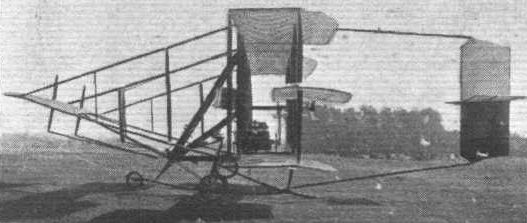
Самолеты Коди
<...>
Опыт, полученный в ходе работы над British Army Aeroplane No.l, был использован при создании в 1910 году усовершенствованного биплана. Коди использовал эту машину в борьбе за первый Кубок Мишлен Британской империи - не удивительно, что самолет общеизвестен как Michelin Cup Biplane. Приз вручался летчику (и самолету), выполнившему самый продолжительный полет по замкнутому маршруту в течение 1910 года. В последний день отчетного года Коди продержался в воздухе 4 ч 47 мин, преодолев 298 км, и стал обладателем кубка. В 1911 году Коди построил новый самолет, очень похожий на предшественников, но с двигателем Green мощностью 65 л. с. (45 кВт). Его целью была премия в 10 000 фунтов стерлингов, установленная газетой "Daily Mail" за перелет на расстояние 1010 миль (1625 км). Circuit of Britain Biplane конструкции Коди стал единственным британским самолетом, выдержавшим это испытание, но летчик финишировал лишь четвертым. На этом же аппарате Коди второй раз выиграл 29 октября 1911 года Кубок Мишлена.
<...>
ТАКТИКО-ТЕХНИЧЕСКИЕ ХАРАКТЕРИСТИКИ
Cody Michelin Cup Biplane
Тип: одноместный гоночный биплан
Силовая установка: один V-образный ПД ENV Type F мощностью 60 л. с. (45 кВт)
Летные характеристики: макс. скорость на уровне моря 105 км/ч
Масса: максимальная взлетная 1338 кг
Размеры: размах крыла включая элероны 14,02 м или 14,94 м; длина 11,73 м; высота 3,96 м; площадь крыла 59,46 м!
- Описание
Фотографии
-
Flight 1930-01 / Flight
It shows the "Flying Cathedral," constructed in 1910 by S. F. Cody, biplane developed from the British Army "flying machine" of 1908-9 which Cody flew with varying degrees of success. The "Cathedral" was 46 ft. span and powered with a 60 h.p. E.N.V. engine. It flew remarkably well, and similar improved and modified models were produced.subsequently.
-
Air Enthusiast 1999-07 / P.Jarrett - Cody and his Aeroplanes
The machine destined to become the Michelin Cup biplane in its first form, at Farnborough, in June, 1910. Only one of the intended two 60hp (44kW) Green engines is installed, though the bed for the other is discernible.
-
Мировая Авиация 104
Коди на встрече авиаторов в Бурнмуте (с 11 по 16 июля 1910 года). На нее прибыли почти все величайшие пилоты мира, включая Блерио. Встреча была омрачена гибелью Чарльза Роллса, соучредителя фирмы "Rolls-Royce", при крушении аэроплана Wright Flyer.
-
Aviation Historian 15 / P.Jarrett - Mr. Cody & Mr. Roe (2)
With the Anglo-French ENV engine from his previous aeroplane installed, Cody's Michelin Cup Biplane proved outstandingly successful, making many flights, carrying passengers and winning the British Michelin Cup plus ?500 prize money.
-
Jane's All the World Aircraft 1980 / Encyclopedia of Aviation - 1. Chronology
British Army Aeroplane No.1 (16 October 1908)
-
Air Enthusiast 1999-07 / P.Jarrett - Cody and his Aeroplanes
A graphic demonstration of stability; George Broomfield stands 10ft (3m) out on the Michelin Cup biplane’s port wing, holding on to the front innermost interplane strut.
-
Мировая Авиация 104
Биплан, на котором Коди участвовал в гонках 1910 года по замкнутому маршруту в Британии (пришел четвертым). Этот аэроплан модифицировали и оснастили новым мотором мощностью 120 л. с. (89 кВт). В 1912 году он прошел военные испытания в Солсбери-Плэйн.
-
Air Enthusiast 1999-07 / P.Jarrett - Cody and his Aeroplanes
Cody takes off from a staging point, possibly in the Worcester and Pershore area, during the Circuit of Britain.
-
Flight 1931-06 / Flight
CODY'S "CATHEDRAL": IT WAS ON A MACHINE OF THIS TYPE THAT CODY WON THE MILITARY TRIALS IN 1912.
-
Aviation Historian 15 / P.Jarrett - Mr. Cody & Mr. Roe (2)
Twin rudders were a distinctive feature of Cody’s Circuit of Britain Biplane, seen here taking off from Brooklands at the start of this gruelling event. It was the only British machine to complete the course.
-
Aeroplane Monthly 1993-10 / ??? - Early birds
Col Samuel F. Cody giving a demonstration in his 1911 Circuit of Britain biplane at Farnborough in the presence of King George V. It was in a later and even larger machine that Cody was killed at Farnborough on August 7, 1913 following structural failure. A procession 100,000-strong and a mile in length marked his funeral at Farnborough.
-
Air Enthusiast 1999-07 / P.Jarrett - Cody and his Aeroplanes
Cody flying his resurrected Circuit of Britain aeroplane before the King during the sovereign’s visit to Aldershot on May 16 and 17, 1912.
-
Air Enthusiast 1999-07 / P.Jarrett - Cody and his Aeroplanes
On January 27, 1912, using his old Michelin Cup biplane fitted with the twin rudders from his Circuit of Britain machine, Cody became the first pilot in Britain to carry four passengers; everybody had seats of the kind usually associated with agricultural machinery.
-
Flight 1930-01 / Flight
AN ANGLO-AMERICAN PIONEER: The late Col. S. F. Cody, who carried out tests with the British Army biplane in 1908-9, and later became a naturalised Britisher.
-
Flight 1935-05 / Flight
Col. Samuel Franklin Cody in the seat of one of his Biplanes. Note how largely bamboo enters into the construction of the machine.
-
Aviation Historian 14 / P.Jarrett - Mr. Cody & Mr. Roe (1)
Samuel Franklin Cowdery, popularly known as “Colonel Cody”, after the surname he “borrowed” from his Wild West hero, Buffalo Bill Cody;
-
Air Enthusiast 1999-07 / P.Jarrett - Cody and his Aeroplanes
This portrait of Cody was taken at Hendon, probably in mid-1912. The safety helmet he is wearing was sold by Gamages, a large department store in Holborn, London, and featured thick felt padding.
- Фотографии
















